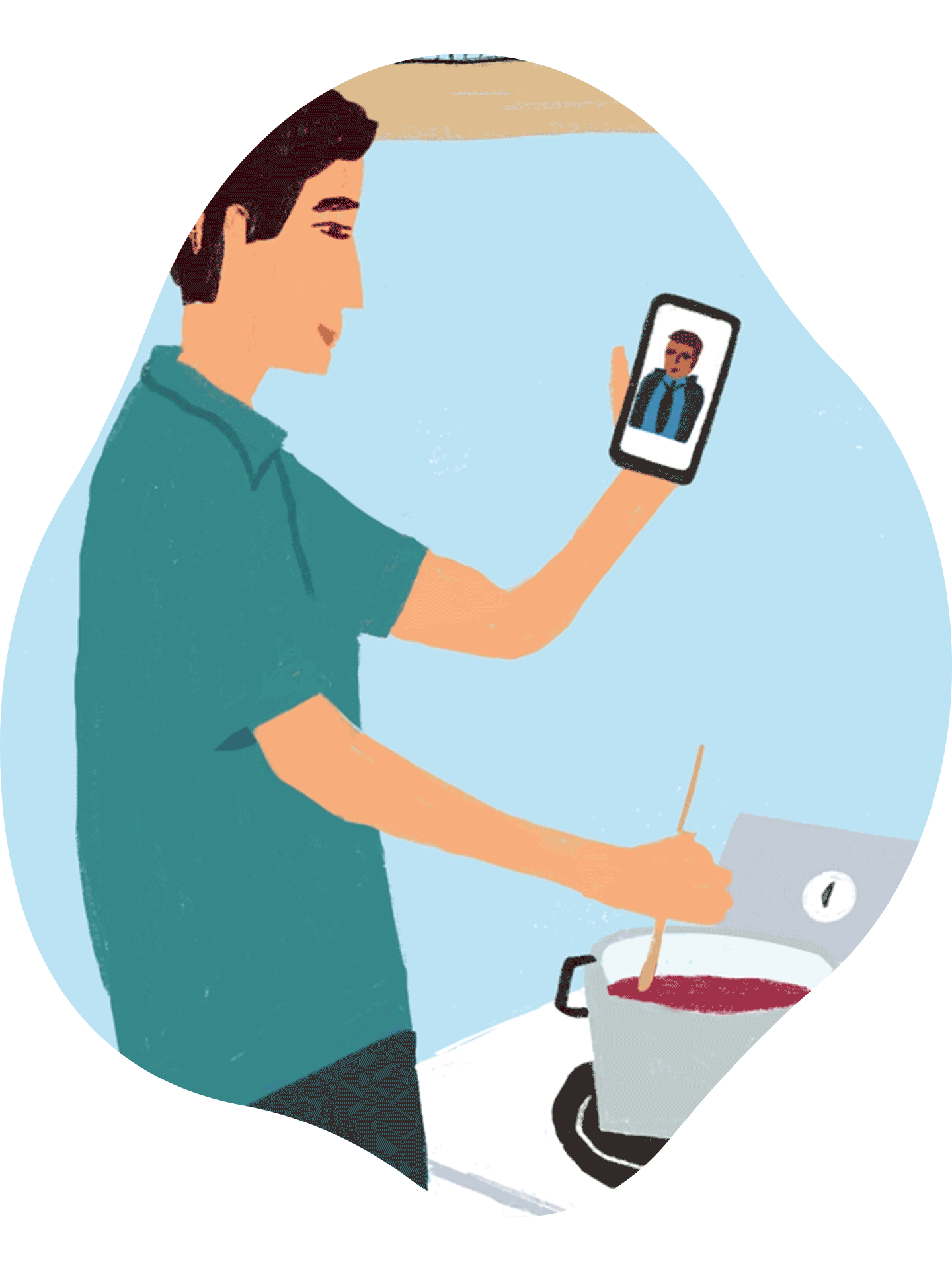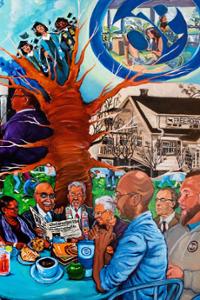
Driving Tech Innovation
Illustrations by Patti Blau
Even at Hamilton, Marc Randolph ’81 was a serial entrepreneur — launching a new outing club, starting a humor magazine, and staging a freshman class play. “It was the kind of place where you could take those creative risks and still have a dorm bed to go back to,” he said. “I learned how to ask for money and enlist people to help me. By the time I started doing it for real, I’d already been doing it for four years at school.”
Randolph went on to cofound the streaming platform Netflix, one of the most successful digital companies today. He’s one of dozens of Hamiltonians who have parlayed their liberal arts education into a technology startup or venture capital firm as digital entrepreneurs from the earliest days of the web to the new frontiers of artificial intelligence. Alumni have played roles in launching and growing Zillow, LinkedIn, PayPal, Peloton, Spotify, Grammarly, and other popular apps on our home screens, as well as other lesser-known digital entities.
“As our late great economics professor Sidney Wertimer used to say, ‘Hamilton trains you for nothing and prepares you for everything,’” said Dan Nye ’88. Skills developed on College Hill — such as resourcefulness and adaptability — are ideal for the innovation economy, which is constantly changing and growing as new technology platforms come online. Nye started working at Dell when it was just a young company in Austin, Texas, before going on to become an executive at Intuit and Advent Software. In 2007, he took on the role of CEO of LinkedIn where he transformed the company from a résumé-posting site to a vibrant business-oriented social network.
“I felt well equipped to understand and engage with technical issues because I’d been prepared to break down problems and think critically and analytically,” Nye said. “Every organization needs people who can communicate clearly and concisely and persuasively, and that’s especially needed in a technical environment.”
As a Hamilton trustee, Nye has been a prime mover behind a new $50-million, 41,000-square-foot innovation center set to open next to Burke Library in 2027. The bright and airy building will provide a dedicated home for the Computer Science Department as well as makerspaces and technologically advanced classrooms. In addition to meeting the explosion of student demand for technology classes, the center will encourage faculty to integrate computing and artificial intelligence into lessons from biology to art history, better equipping the next generation of digital entrepreneurs to follow in the footsteps of alumni who already have shaped the industry.
Birthing a Revolution
“I just happened to be at the right place at the right time, and took advantage of it,” said Blake Darcy ’78, who was working at brokerage firm DLJ in the late 1980s when one of the first internet browser companies, Prodigy, came calling. Darcy, who saw how difficult it was to get customers' information about the market in real time so they could make informed decisions, immediately recognized the internet as a way to do that. The problem was convincing the rest of the financial industry of the wisdom of giving customers the wheel.
“They thought you should really have a broker who understood the market and used the research of the firm — the idea someone was going to place a trade over a personal computer seemed far-fetched,” he said.
Darcy persevered, founding DLJdirect and offering real-time brokerage information to customers through Prodigy and later America Online (AOL); by the time the web came along in the mid-1990s, other financial companies were scrambling to catch up, starting an advertising war, and Darcy’s firm pivoted to the high end of the market. Its initial public offering (IPO) in 1999 was the second largest internet IPO at the time.
Darcy credits the communication and critical thinking skills he learned in English and philosophy classes at Hamilton, as well as a semester he spent in Washington, D.C., as a government major, with helping him make the positive case for his pioneering online brokerage firm, which set the stage for E*Trade, Robin Hood, and other firms to follow.
“Who would have said I was going to run the largest online commerce company in the country?” Darcy said — after all, when he came to Hamilton, online commerce didn’t even exist. “What you need to succeed is flexible persistence, because things change quickly, and you have to be able to move from one thing to another, but at the same time stick with your vision.”
“Every organization needs people who can communicate clearly and concisely and persuasively, and that’s especially needed in a technical environment.
From the beginning, the company pioneered a matching algorithm it called Cinematch to recommend movies to users, the precursor to now ubiquitous recommender engines all over the internet. Randolph envisioned a day when the company could deliver films through digital download, but never imagined streaming media as Netflix and companies ranging from Hulu to Peacock do today. He knew the company had succeeded when he read a clue in The New York Times crossword puzzle for “service with a queue.” “It was a seven-letter word with an X at the end,” he remembered. “I said, ‘Oh my God, it’s actually Netflix in The New York Times.’”

Since leaving Netflix in 2003, Randolph has served as a board member for more than a dozen other companies and organizations, including Hamilton, where he has returned several times to mentor students. “Working with students is a tremendous source of energy for me,” he said. “They have the right blend of talent and ambition, but still have a lot of flexibility as they harbor all these dreams of making their ideas real.”
Transforming Media and Finance
Greg Schwartz ’94 also started out working in advertising, selling one the first ad campaigns on AOL. He soon leapt into digital media, working for Yahoo! and CNNMoney. com before joining startup real estate site Zillow as vice president of sales in 2007. “They were looking for a business person to figure out how to monetize the site,” he said.
In one of his first endeavors, Schwartz asked for a single software engineer, and the chairman told him to hire 20. “It taught me the West Coast attitude toward product development, which is all about taking big swings,” he said. Schwartz rose to become president of Zillow’s media and marketplace business before leaving in 2020 to found Tomo, a company that aims to use automation and artificial intelligence to streamline the mortgage industry and overcome customer frustrations on closing properties.

“There’s a formula my friends and I use, which is to look for massive markets, where customers feel like they are being taken advantage of, and in which the incumbent is overcharging for service,” Schwartz said. “You might have the chance of building something big.”
He described the first few years as both joyful and harrowing. “As an entrepreneur, you are responsible for all the wins and losses — and we had no idea whether it was going to work out,” he said. His efforts have paid off, however, as the company has raised $130 million in investment funding to put it on track to soon be one of the nation’s largest mortgage companies.
Schwartz’s classmate Samantha Skey ’94, a comparative literature major, started at a New York literary agency after Hamilton before jumping ship to begin working in digital media in the late 1990s. “I didn’t even know how to use email when I first started,” she remembered, but she quickly learned her way around technology working for companies including CNET, where she was embedded in early internet startup culture, with “a dog and a bunk bed” in the office. After stints at Disney and a clean tech company, she joined startup blogging company SheKnows as chief marketing officer in 2013.
Skey has since helped it grow into SHE Media, a conglomerate of 1,000 sites focused on women’s health and parenting, where she now serves as CEO. Having worked at the Women’s Center and volunteering for a rape crisis counseling organization while at Hamilton, she was drawn to the company’s mission supporting women, who are often neglected as an audience online. At the same time, data shows women over 40 make up one of the most lucrative demographics when it comes to advertising, allowing the company to be profitable as well. It now attracts some 75 million monthly visitors.
While at Hamilton, Andy Berman ’06 met future Facebook founder Mark Zuckerberg, who happened to be friends with his roommate Seth Coburn ’06. Four years after graduating, Berman joined Facebook as one of the first employees in its New York ad office. He thrived in the early days of the company, when young people in hoodies and flip-flops were closing multimillion-dollar ad deals.
“It was full of really smart and creative people who did not belong in a suit-and-tie environment,” remembered Berman, who closed the company’s first deals over $10 million with Walmart and American Express. “We were built around this narrative that there’s this new thing called social media that is growing faster than any media technology ever has — and if you invest in it early, you will have a huge head start relative to your competitors.”
“[Facebook] was full of really smart and creative people who did not belong in a suit-and-tie environment.
Over the next decade, he watched as the company grew into a multi-billion-dollar company, and by 2020, he was head of audience network business across the Americas. He’s since gone on to Glade Brook Capital, a venture capital firm that invests in established companies to take them to the next level. Berman has used his expertise in strategy and finance to advise companies such as Stripe, Instacart, and Indian ecommerce site Zepto. “I spend a lot of time with founders, helping them think through the evolution they need to get from the $15 million they are making today to $150 million in the future,” he said.
Helping businesses prosper in a different way, Rezaan Daniels ’07 worked for a number of companies helping develop sustainable enterprises overseas before founding his own firm, Finvx, in 2019. Originally from South Africa, Daniels saw a gap in the market when it came to investing in overseas companies, often leaving them struggling to obtain working capital.
“The number one reason small businesses fail isn’t lack of profitability, it’s running out of cash while they wait 90 days to get paid,” he said. Finvx bridges that gap with a platform that allows it to pay companies in advance, and then collect directly from their customers, taking a portion of the sale.
Daniels was a world politics and government major at Hamilton but also worked in the library where he would read old copies of MIT Technology Review; for spring break his freshman year, he and some friends bypassed Fort Lauderdale to visit Silicon Valley — they still jokingly refer to Hamilton as “Ham Tech.” However, it was the anthropology classes he took that gave him the versatility to speak across cultures both internationally and within the firm.
“When you are bridging finance and technology, it’s really important to figure out the storytelling piece,” he said. “If we are in a finance meeting, we need to speak the language of finance; if it’s a tech call, we need to speak that lingo. You can have a great, innovative solution, but if you are not able to get people on board with the story, you are not going to succeed.”
Crafting a New Intelligence
Not surprisingly, many of the newer startups that Hamilton alumni are involved with focus on the use of artificial intelligence (AI), which has transformed the tech landscape in just a few years with an explosion of generative AI such as ChatGPT and other technologies. Unlike some Hamilton entrepreneurs who started in the humanities and transitioned into tech, Indraneel Das ’94 took the opposite route, studying mathematics and computer science and working as a data analyst for IBM and ExxonMobil before moving into the world of digital finance.
After earning an MBA at Columbia, he founded Pearl Brook Capital Management in 2014, focused on finding hidden gems in emerging markets. In 2021, he launched a new company, MQ Technologies, that combines AI and asset management to artificially mimic the investment strategy of a particular trader by converting their market decisions into data AI can use. The firm is working to offer off-the-shelf products based on the strategy of well-known investors such as Warren Buffett and Bill Ackman, as well as with investment managers who want to optimize their own strategies.

At the same time, Das is raising seed funding for a second startup, Multiplicity Solutions, which hopes to transform education using AI. Unlike other firms looking to replace teachers with AI platforms, he said, the company would help teachers use AI to supplement their teaching in order to reach more students.
“A teacher can essentially clone herself, training her AI to teach lessons and answer questions, and reach six to 10 times the number of students,” he said. The company could help solve both the shortage of teachers and allow teachers to be paid more adequately for their skills. Initially targeting the homeschooling market, Das eventually envisions building a school that would integrate teachers with AI, to allow students to chart their own path through their studies with teacher support.
Sam Reider ’14 has been applying AI to transform the field of behavioral health counseling as vice president of engineering at the startup Charlie Health. The company focuses on intensive outpatient therapy in which patients are participating in over 10 hours a week of individual and group therapy, dealing with problems of scarcity and high expense through a virtual environment.

A computer science major at Hamilton, Reider previously worked at electronic health record company Practice Fusion, where he found the writing skills he gained in college came in handy as he tested code. “Whenever you find a bug, you have to write a ticket describing it, and I started gaining some clout within the organization, because they were like, these bug tickets are amazing,” he remembered.
After joining Charlie Health in 2021 as the first software engineer, he has since grown a team of 50 engineers, transitioning from a system using Zoom calls and spreadsheets to a fully integrated platform that connects therapists and patients with a click of a button. Not only can the system offer therapy with more convenience and lower cost, he said, but it also uses AI to summarize group sessions and provide notes for therapists they can consult in real-time during a session to offer better service.
“We have this great opportunity to give care providers superpowers,” Reider said. “By building better technology, we help care teams be better at their jobs and deliver better outcomes.”
At Microsoft, Jeremy Mathurin ’16 is using AI to improve efficiency in the public sector as part of a team rolling out the new AI companion CoPilot starting late last year. After Hamilton, he worked at Deloitte Consulting, where he used robotics and automation to help government agencies do their jobs better. Microsoft was his “dream company” to work for — a giant tech company that nonetheless thrives by working with partnerships rather than trying to own every piece of its ecosystem. Despite being at a huge company, Mathurin has been able to pursue innovation as an “intrapreneur,” employing almost a startup mentality with the AI team.
“There’s a lot of pressure for government to operate more efficiently and do more with less,” he said. “Generative AI is one of those tools that can help organizations do more with more, improving efficiency without having to necessarily spend more or develop a lot of new skills.”
Its free product, CoPilot Chat, allows government workers to write prompts, similar to ChatGPT, but it protects their data, so that content and queries provided are not used to train the model. Its paid product, 365 CoPilot, is integrated into Microsoft’s Office applications, helping summarize emails on Outlook, draft documents in Word, or perform data analytics in Excel.
At age 30, Mathurin is responsible for overseeing work with government agencies in the entire eastern half of the country. “It all starts with the foundational skills and mindset from Hamilton,” he said. “Even with things like generative AI, having the ability to think critically is not going out of vogue. Those critical thinking skills have allowed me to be a better leader, to communicate, to be persuasive, and to translate between disciplines. That all came from Hamilton.”
“It all starts with the foundational skills and mindset from Hamilton. Even with things like generative AI, having the ability to think critically is not going out of vogue.
Coby Berman ’12
Co-founder and COO of the geolocation platform Radar; formerly with mParticle and Foursquare.
Woody Marshall ’90
General partner, TCV; involved with investments in GoFundMe, Instacart, Peloton, SeatGeek, Spotify, and others.
Abby Homer Reider ’16
Head of corporate communications, Figma; former global corporate and financial communications lead, DoorDash.
Rahul Roy-Chowdhury ’95
CEO, Grammarly; former VP, product management, Google.
Phil Sanderson ’90
Managing partner, Griffin Gaming Partners; investor in Discord, Phoenix Labs, Vivox, Triller, Funzio, and more.
Jack Selby ’96
Managing director, Thiel Capital; one of the first employees at PayPal.
Ware Sykes ’99
CEO, Seasoned (professional social network for hospitality workers); former CEO, Nowait, acquired by Yelp in 2017.
Brian Truesdale ’92
Chairman of global technology banking, capital markets, and advisory, Citigroup; former global head of software investment banking, JPMorgan.
Rachel Weiss ’93
Early-stage venture capital investor, L’Oreal Bold.
About the Author: Michael Blanding is a journalist whose pieces have appeared in The New York Times, WIRED, Smithsonian, Slate, The Nation, and The Boston Globe Magazine. He is the author of several books, including The Map Thief: The Gripping Story of an Esteemed Rare-Map Dealer Who Made Millions Stealing Priceless Maps (2014), which was a New York Times bestseller and an NPR Book of the Year.
About the Illustrator: Patti Blau is an artist and illustrator with a BFA from Parsons School of Design. Her work can be found at pattiblau.com.
Posted July 24, 2025




